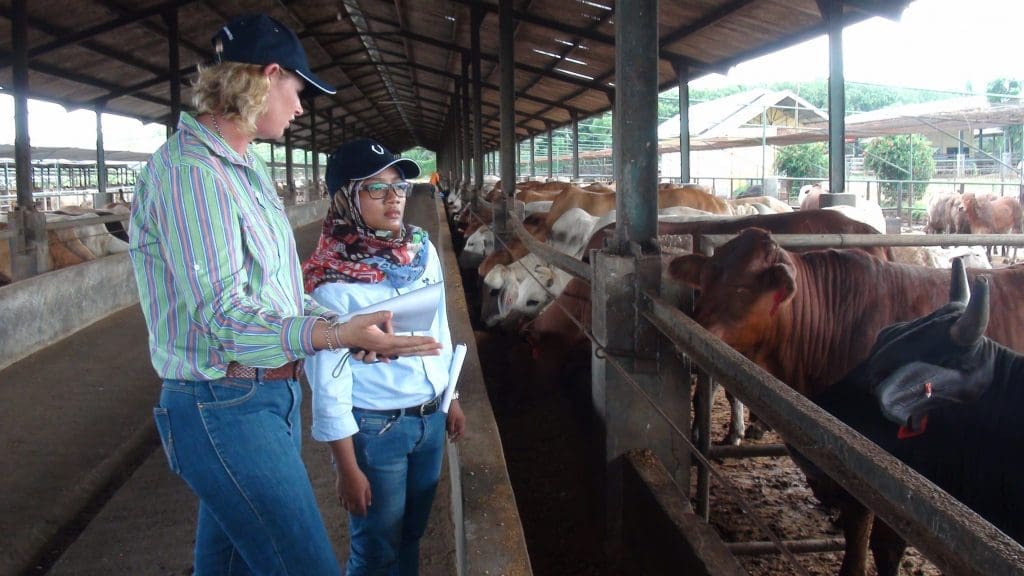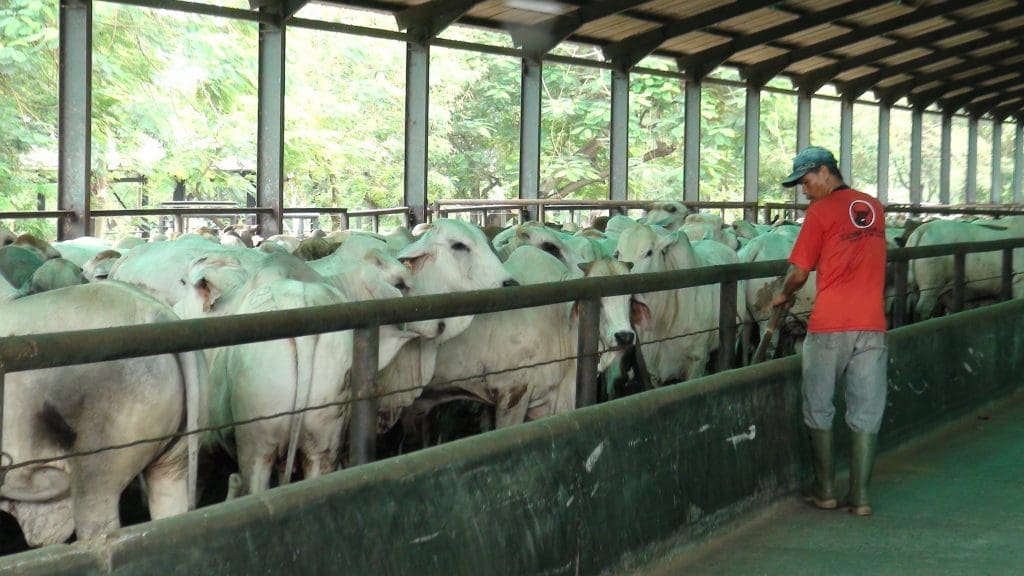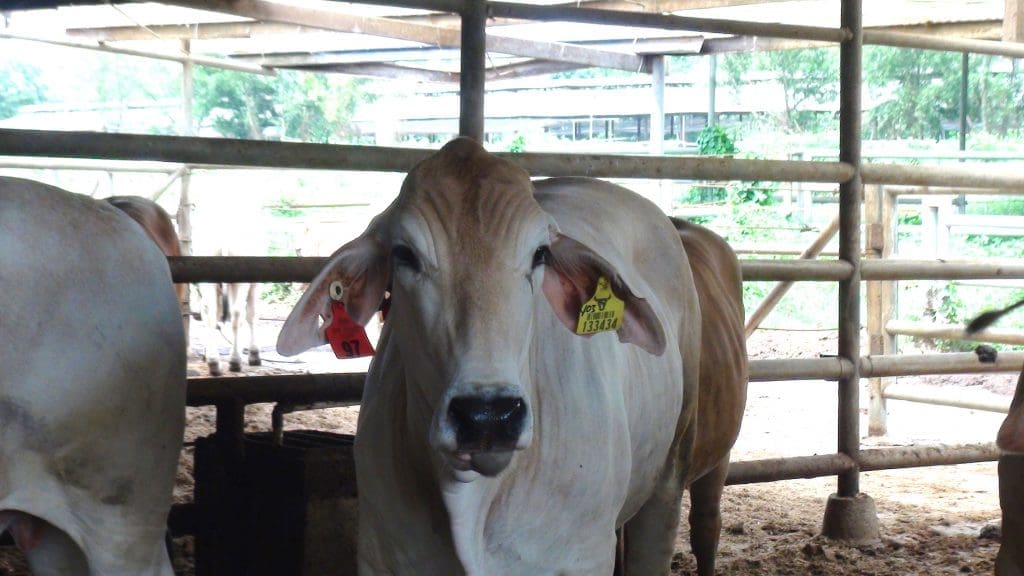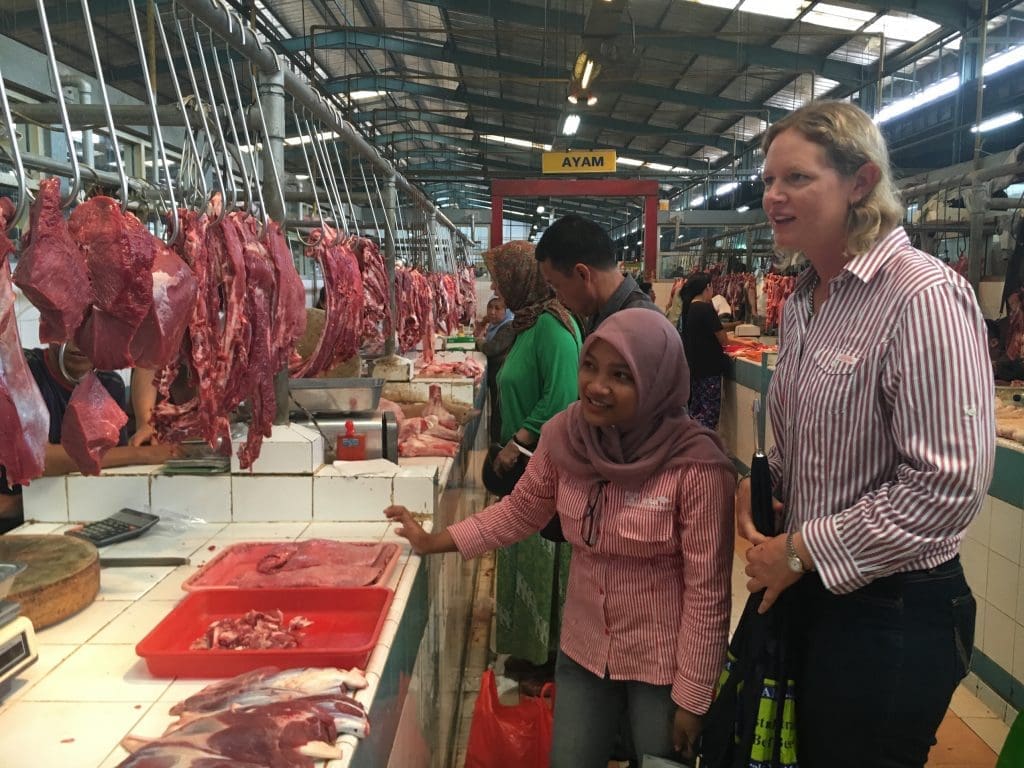Tania Hartwig from Monto in Queensland was selected to judge the Nutrition Service Associates Feedlot Steer Competition in Indonesia earlier this month. Tania had no previous experience with the live export industry but produces both commercial and stud cattle and has ample judging experience. Here she explains what she saw and the impressions she gained of Indonesia’s cattle industry.

Tania Hartwig and associate judge Febrina Prameswari, who is an NTCA graduate, judging cattle at the Elders Feedlot in Indonesia.
What I experienced when I travelled to Indonesia to judge the Nutrition Service Associates Feedlot Steer Competition, was completely different from what I expected.
As a cattle producer, this was my first direct involvement with the live export industry.
Previous images and media stories of negative treatment in Indonesia of export cattle left me with some doubts as to what really happened to the cattle once they left Australian shores.
However, all of my doubts were unfounded.
I experienced the complete opposite to what has been portrayed in some sections of the Australian media and was pleasantly surprised.
In the four feedlots I judged, I found the cattle to be equal in quality, health and condition – as it should be – with those in Australian feedlots.
Animal welfare was a clear priority; the feedlot facilities were of a very high standard; the feedlots were clean; and the cattle were well-cared for by skilled and dedicated workers.
The staff I met and spoke with took such pride in their work and with training provided by Australia, there is no going back for these people, their appetite for new information and the willingness to implement new practices should not be underestimated.
Having sent my own cattle into feedlots and entered them into feedlot/carcass competitions, if I were the feedlot owners and breeders of the cattle, I would have been proud to put my name to the cattle I saw and had the privilege to judge while in Indonesia.
A number of the cattle brands I saw were familiar to me, with cattle coming from family operations to large corporates.
Despite this, it was a level playing field, and I think this competition is important for the breeders to see what their cattle are doing in Indonesian feedlots and test if the genetics are working in the feedlot environment.
The whole judging experience was fascinating. The conformation of the cattle was good, despite the potential for issues being on hard surfaces, fat score of the cattle was impressive and their temperament was exceptional.
I also commend the ability of the feedlot managers and staff who selected their top 10 steers out of pens of hundreds, they certainly have an eye for cattle that will perform.
Obviously all cattle were Bos indicus and short coated to allow for the warm and humid conditions in Indonesia.
While the weight of the cattle upon entry to the Indonesian feedlots was slightly lower than what would go into Australian feedlots, the end product was outstanding.
It is fascinating to see how Australian cattle perform in the Indonesian feedlot conditions.
Although the daily weight gain is not as high in Indonesia as in Australia, the feedlots are continually improving and this is one of the reasons the staff told me they entered the Feedlot Steer Competition, to get feedback, and then improve.
As producers in Australia we know obtaining the right feedback can sometimes be a challenge, however this Competition is helping to ensure feedback is applied across the whole supply chain.
Indonesian feedlots typically feed cattle for 120 days, whereas Australian cattle are fed for 100 days to a similar end-point.
It is clear to me that the trade plays to both countries natural advantages – we can breed them (particularly in Northern Australia) and Indonesia can feed them (certainly beyond our capability in Northern Australia).
The feedlot rations were different from Australia’s, but other than a slightly lower average weight gain, this didn’t appear to have any negative impact.
Nothing went to waste, as the roughage in the rations included local by-products from other industries, such as palm leaves that wouldn’t be used anywhere else.
It was impressive to see the feedlot production system adapted to suit local needs.
They are innovative and they know that feeding the cattle well, will result in a better end-product.
I was impressed with the dedication of the local workers and I saw no mistreatment of animals.
‘Animal welfare was a top priority’
Animal welfare was a top priority.
There were shade areas available for animals to get out of the sun, while the temperament of the cattle was quieter than I expected, due to the high amount of human contact they have. I’m not suggesting the facilities are perfect, but it was encouraging to see the effort put in and the workers’ pride in everything they do. This clearly translates to quiet, healthy cattle.
The main improvement I could see was the need for a layer of cushioning on the concrete pad to improve comfort and potentially weight gain.
I could see an exciting opportunity to continue to share information with Indonesia to help improve some of the feedlot operations, such as shade, clean water and manure management.
One of the biggest surprises to me was visiting the wet market and discovering all cattle are slaughtered at night, so they are fresh for customers early the next morning.
If the meat is warm, it’s fresh. I’ve heard the argument that Indonesians don’t have refrigeration so they need their meat fresh.
I’ve also heard the counter argument from animal welfare groups that this claim is false. There is certainly a growing hotel and restaurant trade, however for the remainder of the enormous population, I found the majority purchase their meat fresh from the wet market, because that’s what they prefer.
Although I didn’t experience any processing facilities or abattoirs, because it wasn’t part of the competition, on the visit to the wet market I didn’t see any dark cutting meat, which would have indicated some kind of stress.
This was really pleasing as I saw what a great job the feedlot sector is capable of doing.
My experience proved there are two sides to every story.
I now feel confident to advocate the advantages of exporting cattle with the knowledge of the feedlots I visited and that the Indonesian industry is doing everything it can to improve and care for the livestock in their facilities.
The experience reinforced how important Indonesia and the live export cattle trade is to the Australian beef industry.
I am really encouraged by this Competition and how it can help producers like me understand what the market wants.
The Feedlot Steer Competition winner will be announced at the LEP Expo in Indonesia on April 6.






Good story, pleased to hear about feedlot conditions and continual improvement philosophy.
Good report Tania. We were a part of the Trade Mission to Indonesia last November, and we were also impressed with the standard of sophistication of the beef industry, including welfare. We were amazed however at the ability of the feedlots to feed cattle on essentially waste fodder products!
Thanks Tania, for your independent assessment.
Thankyou Tania for a very well informed and balanced account of your trip, and your impression of the way our cattle are handled once they arrive in Indonesia. With the dedication of people like yourself things can only improve for the benefit of both countries and the welfare of our animals.